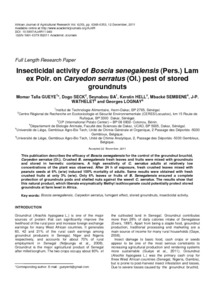Rwanda is among the top 10 producers of potatoes in Africa, with a production area of an estimated 106,263 ha. Nevertheless, their crop yield remains very low due to various factors, including pests and diseases. The potato cyst nematode is one of most important pests of potato worldwide, with the potential to cause more than 70% yield losses (Turner and Subbotin 2006). At present, only limited research on the nematodes associated with potato in Rwanda has been conducted, and their diversity and potential impact on crops remain poorly documented. During a survey conducted in August 2017 to characterize the plant-parasitic nematodes associated with potato in Rwanda, rounded cysts were found in four of the 10 samples collected, following extraction using the Baunacke (1922) method. The highest density of cysts (89 cysts/100 cm3 of soil) was found in Rubavu (1°36′43.29″S, 29°26′16.7″E), and lower densities of 17, 8, and 7 cysts/100 cm3 of soil were recorded in Musanze (1°27′31.4″S, 29°31′16.0″E), Rubavu (1°35′52.4″S, 29°23′03.3″E), and Burera (1°23′00.6″S, 29°48′00.9″E) districts, respectively. The nematodes (cysts and second-stage juveniles) were morphologically identified as Globodera rostochiensis (Wollenweber, 1923) Skarbilovich, 1959. Cysts were brown in color, spherically shaped with a protruded neck, and circumfenestrate without bullae; the Granek’s ratio ranged from 3.5 to 4.5. Second-stage juveniles were 409 (398 to 437) µm long with a slightly C-shaped body after fixation, tapering at the posterior end and with four lateral lines; labial region slightly offset, anteriorly rounded; stylet well developed, 20.6 (19 to 22) µm long with rounded knobs; tail 46 (42.3 to 51.1) µm long with a prominent hyaline tail part of 25.9 (21.8 to 32.2) µm long, with a finely rounded to pointed terminus. The morphological identification was confirmed by ITS rDNA sequence data (GenBank accession codes: MK758068, MK758069, MK758070, and MK758071) following Singh et al. (2018) with AB28 and TW81 primers as described by Joyce et al. (1994). With Bayesian inferences, the Rwandan population formed a maximally supported clade together with other G. rostochiensis populations. The Rwandan sequences were found to be 99.8 to 100% (0 to 2 nucleotides difference) identical to G. rostochiensis from Serbia (HM159430 and KR057953). To confirm the host suitability of this species, potatoes of the Musanze farm were resampled in October 2018. The potato plants presented small tubers, and close examination of the root system revealed tiny yellow and brownish cysts attached to the roots. These cysts were subsequently extracted, with five being crushed and inoculated on potato tuber (Solanum tuberosum L.) cultivar Kinigi in separate sealed containers with 200 cm3 of sterile sand and 30 ml of water (Foot 1977). The reproduction factor after 120 days was 16 ± 6, indicating that Kinigi, the leading potato variety in Rwanda, represents a suitable host for the recovered G. rostochiensis population. To our knowledge, this is the first recorded finding of G. rostochiensis in Rwanda. This species is a pest of quarantine importance in many countries, including Rwanda, and its presence has also recently been reported in Kenya (Mwangi et al. 2015). Because the present study was based solely on a limited number of samples, it is clear that a more detailed study is urgently required in order to investigate the distribution of G. rostochiensis and to assess its potential economic impact on Rwandan potato production.
First Report of Potato Cyst Nematode (Globodera rostochiensis) Infecting Potato (Solanum tuberosum) in Rwanda
Citation: Niragire, I., Couvreur, M., Karssen, G., Uwumukiza, B., & Bert, W. (2020). First Report of Potato Cyst Nematode (Globodera rostochiensis) Infecting Potato (Solanum tuberosum) in Rwanda. In Plant Disease (Vol. 104, Issue 1, p. 293). Scientific Societies. https://doi.org/10.1094/pdis-04-19-0891-pdn
2021-03-15
IMPACT ASSESSMENT, INCLUSIVE GROWTH, POTATO AGRI-FOOD SYSTEMS, POTATOES
Eastern Africa
RWANDA
journal_article


